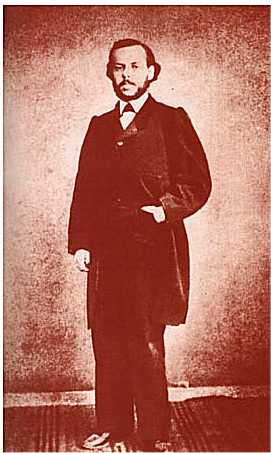Augusto Ferrán facts for kids
Quick facts for kids
Augusto Ferrán
|
|
|---|---|

Augusto Ferran y Fornies
|
|
| Born | July 7, 1835 Madrid |
| Died | April 2, 1880 (aged 44) Madrid |
| Occupation | Poet |
| Language | Spanish |
| Nationality | Spanish |
| Education | Instituto del Noviciado |
| Literary movement | Postromantic |
| Notable works | La soledad |
Augusto Ferrán y Forniés (born July 7, 1835, in Madrid – died April 2, 1880, in Madrid) was a Spanish poet. He was known for his unique style during the Postromantic period, a time when writers explored deep feelings and emotions.
Contents
About Augusto Ferrán
Augusto Ferrán was born in Madrid on July 7, 1835. His parents were from Catalan and Aragonese families and were quite wealthy. Their family business made fancy gilded moldings.
When his father went to Havana to find more opportunities, Augusto began studying at the Instituto del Noviciado. He later traveled to Germany, passing through Paris. There, he discovered the poetry of Heinrich Heine and the music of Friedrich Schubert, Felix Mendelssohn, and Robert Schumann.
In 1859, his mother passed away, and he returned to Madrid. Back home, he started a magazine called El Sábado. His goal was to share German lyric poetry with Spanish readers. The magazine didn't last long, but it helped him meet and become friends with Julio Nombela, a writer. Together, they started another short-lived magazine, Las Artes y las Letras.
In 1860, Ferrán traveled to Paris with Nombela. However, he faced money troubles and had to return to Madrid. There, Nombela introduced him to another famous poet, Gustavo Adolfo Bécquer.
In late 1861, a magazine called El Museo Universal published his "Translations and Imitations of the German Poet Heinrich Heine." Other works of his appeared in Almanaque in 1863. He got a job at El Semanario Popular, which finally allowed him to share Heine's work widely in Spain.
His Famous Book: La soledad
By 1861, Ferrán's book La soledad (meaning Solitude) was published. The first part of the book included several popular traditional songs. The second part featured his own poems, which were inspired by the style of these songs.
His poems often talked about:
- Searching for quiet places to escape a difficult world.
- The difference between rich and poor.
- How time passes quickly.
- Deep thoughts about life and existence.
- Love.
The famous poet Gustavo Adolfo Bécquer loved the book. His encouraging words were even added as an introduction in later editions. Ferrán helped create a popular style of poetry based on songs, much like Heine's work. Other poets like Rosalía de Castro and Gustavo Adolfo Bécquer were also writing similar poems around this time. This style later influenced a group of poets known as the Neopopularist school.
Later Life and Works
Ferrán spent some time in the Veruela monastery in 1863, after visiting it several times before. He also lived in Alcoy for a while, where he managed the Diario de Alcoy newspaper from 1865 to 1866. But he eventually moved back to Madrid.
He might have worked on La Ilustración de Madrid, a magazine that Bécquer directed in 1868. After Bécquer passed away, Ferrán helped prepare a special edition of Bécquer's collected works in 1871.
In that same year, Ferrán published his second book of poems, La pereza (meaning Laziness). This book included new poems and some articles he had written for newspapers. Like his first book, it used popular song rhythms. It also featured different types of Spanish folk songs like soleás and seguidillas. The themes were similar to his first book, but this one had even more folklore (traditional stories and beliefs).
The famous poet Juan Ramón Jiménez loved a poem from this book, which is shared below:
-
-
-
-
-
-
-
-
-
- Eso que estás esperando
- día y noche, y nunca viene;
- eso que siempre te falta
- mientras vives, es la muerte.
-
-
-
-
-
-
-
-
Around 1872 or 1873, Ferrán moved to Chile, where he reportedly got married. He returned to Madrid in 1878. Sadly, he was admitted to a hospital in Madrid, where he passed away on April 2, 1880.
His Impact on Poetry
Ferrán's poetry was different from older, more formal styles. His poems sounded more like everyday speech. He used simple words to express deep and personal feelings. This brief and confident style was later followed by other important poets like Bécquer, Antonio Machado, and Juan Ramón Jiménez.
Besides poetry, Ferrán also published translations from German and several legends (old stories). His translations of Heinrich Heine's works appeared in different magazines. He often used a mix of seven-syllable and eleven-syllable lines, similar to Bécquer's style. He also translated Heine's famous introduction to Don Quijote.
Some of his legends include:
- "El puñal" (The Dagger), which tells a mythical story about how the Veruela monastery was founded.
- "La fuente de Montal" (Montal's Fountain), where a magical fountain helps solve a crime.
Works
Poetry
- La soledad (1861)
- La pereza (1871)
Prose
- "Una inspiración alemana" (An German Inspiration), in Revista de España, (March 1872).
- "El puñal" (The Dagger), a legend published in El Museo Universal (1863).
- "La fuente de Montal" (Montal's Fountain) (1866)
- "El sapo concho" (1868)
See also
 In Spanish: Augusto Ferrán para niños
In Spanish: Augusto Ferrán para niños
- Spanish Romance literature

